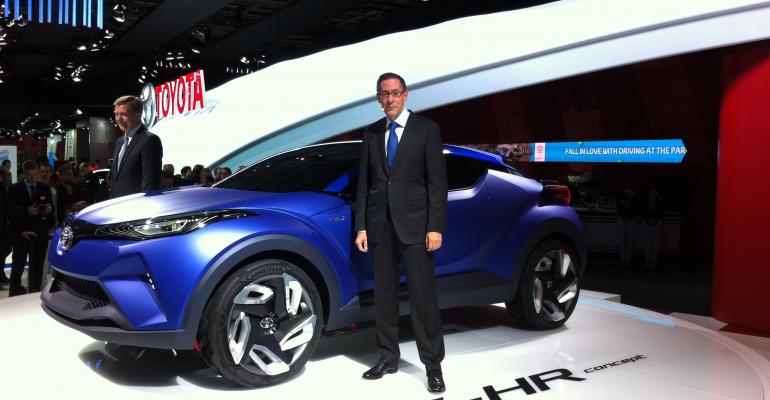PARIS – Toyota Europe unveils the C-HR Concept, a CUV in the spirit of the RAV4 it bills as a “unique look” at the segment and featuring the Japanese automaker’s latest take on its successful hybrid technology.
“This concept is the synthesis of more than 20 years of Toyota creativity,” says Karl Schlicht, executive vice president-sales at Toyota Europe.
“Just as the first RAV4 brought a fresh and totally unique view to the 4x4 market, C-HR represents Toyota’s unique view of the (CUV) segment,” he says in a press conference to open the 2014 Paris auto show.
 Unlike the utilitarian production Toyota Prius hybrids, which have enjoyed particular success in North America, the C-HR concept is seen pushing the automaker’s future offerings in the space to a new level of styling and driving dynamics.
Unlike the utilitarian production Toyota Prius hybrids, which have enjoyed particular success in North America, the C-HR concept is seen pushing the automaker’s future offerings in the space to a new level of styling and driving dynamics.
It is expressive with its muscular haunches, raked windshield and shrunken greenhouse. But it also is meant to be agile, suggesting CEO Akio Toyoda’s promise of building vehicles with greater driving excitement.
The design of the C-HR draws heavily from the demands of the European market, Schlicht adds, a region where the focus is on the A, B and C segments. It was penned by the automaker’s studio in Southern France, ED2.
Schlicht stops short of providing details on updates to the concept’s hybrid system, but boasts it will “reset the standards for (fuel) consumption and (carbon-dioxide) emissions.”
Toyota today commands hybrid leadership globally and consumers in Europe are choosing the automaker’s technology more frequently, says Didier Leroy, president and CEO at Toyota Europe.
Driven by popularity of the Yaris Hybrid and Auris Hybrid, as well as alternative propulsion offerings from the Lexus luxury brand, Toyota hybrid sales have reached 780,000 units in the region since the Prius went on sale here in 2000, Leroy reports.
In the first eight months of 2014, sales of the automaker’s hybrids reached 107,000 units, or 28% of Toyota group volume in Western Europe.
Speaking more broadly, Didier says the automaker doubled its operating profit in the 2013-2014 timeframe after restructuring the unit between 2010 and 2012. The gains have come, he says, without the benefit of a favorable yen-to-euro exchange rate and against industry headwinds in Russia.
So far this year, Toyota Europe sales are up 5%, against a market up just 1.5%, and Lexus sales have surged 20%. “Looking ahead, we have every reason to remain optimistic,” Leroy says.
The executive cites the new-generation Aygo and the redesigned Yaris, which give Toyota Europe a fresh one-two punch in the pint-sized market.
“We are confident these models will reinforce our position in the all-important A- and B-segments,” Leroy says.
The automaker also shows a previously revealed i-Road electric vehicle here, as well as the Toyota Fuel Cell Sedan, to underscore its vision of a European market demanding multiple alternatives to improving efficiency.





